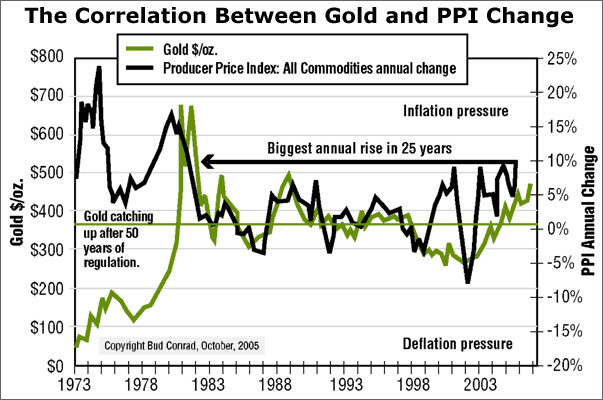 Measuring Gold's Link to Inflation Measuring Gold's Link to Inflation
The Casey Files
The
International Speculator
Nov 10, 2005
In the current issue of
the International Speculator, we presented a analytical
article on the link between inflation and gold. (To receive a
copy, click
here.)
Included in the article
is a chart by analyst extraordinaire, Bud Conrad, showing
the long-term linkage between the Producer Price Index (PPI)
and the price of gold.
Given the recent surge in
both the CPI and the PPI, I asked Bud to do a brief follow-up,
presented here. If you're interested in profiting from precious
metals, take a look.
-Doug Casey
Chairman, Casey
Research, LLC.
The chart plotting the rate
of change in the Producer Price Index (PPI) against gold paints
a remarkably clear picture. But to understand why that picture
is not just a coincidence, consider why gold is always in demand.
Gold is real money, and it's
been real money from the beginning of recorded history. Specifically,
while government-printed paper currencies come and go, gold has
been respected as a medium of exchange and a store of value throughout
countless generations.
But the dollar and other paper
currencies have advantages of their own, especially their greater
short-term stability of purchasing power. So gold and
the dollar compete for the attention of investors and consumers.
And when inflation rates rise, the dollar's appeal versus gold
weakens.
Movements in the Producer Price
Index (PPI) are a good -- perhaps the best -- barometer of inflation,
because the PPI is free of much of the statistical "noise"
that goes into the more familiar Consumer Price Index.
In the chart below, any rate
of change in the PPI above 0% means inflationary pressure in
the economy. Below 0% means deflationary pressure.
As you can see, with some explainable
exceptions, the PPI and gold move together. You can also see
that the trend is currently in place for both higher inflation
and higher gold prices.
Of course, forecasting PPI
inflation is no easy matter. But the chart does tell us emphatically
that when we see growing forces for inflation -- rapid expansion
in the money supply engineered by the Federal Reserve, artificially
low interest rates, growing government deficits, unsustainable
trade imbalances and currency competition -- we should expect
rising gold prices.

About Bud Conrad:
Bud Conrad holds a Bachelor of Engineering degree from Yale University
and an MBA from Harvard. Among others, he has held positions
with IBM, CDC and Amdahl. Currently he serves as a local board
member of the National Association of Business Economics and
teaches graduate courses in investing at Golden Gate University.
Conrad's charts regularly grace
the pages of Doug Casey's International Speculator, a
publication devoted to high-profit opportunities in mining stocks.
To receive a no-risk, three-month
subscription to the International Speculator, click here.
321gold Inc

|